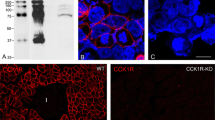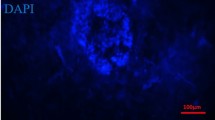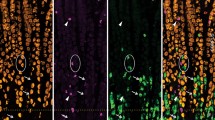Summary
The ultrastructure of immunohistochemically identified PP cells has been investigated by applying the serial semithin/thin section technique to the human pancreas, with special reference to the posterior part of the head, reputed to originate from the ventral primordium. PP cells of this area differ from those already identified in the rest of the pancreas and correspond to a cell, not yet described in the human pancreas, characterized by larger granules of very variable shape and structure. Such granules resemble those of so-called “F cells”, i.e. the PP cells of dog uncinate process and cat duodenal lobe, also coming from the ventral primordium. Thus, human “ventral lobe” PP cells have peculiar potentialities which are expressed in distinctive structural patterns of presently unknown functional meaning.
Similar content being viewed by others
References
Baetens D, de Mey J, Gepts (1977) Immunohistochemical and ultrastructural identification of the pancreatic polypeptide-producing cell (PP-cell) in the human pancreas. Cell Tissue Res 185:239–246
Bencosme SA, Liepa E (1955) Regional differences of the pancreatic islets. Endocrinology 57:588–593
Bergstrom BH, Loo S, Hirsch HJ, Schutzengel D, Gabbay KH (1977) Ultrastructural localization of pancreatic polypeptide in human pancreas. J Clin Endocrinol Metab 44:795–798
Bordi C, Togni R, Baetens D, Ravazzola M, Malaisse-Lagae F, Orci L (1977) Human islet cell tumor storing pancreatic polypeptide: a light and electron microscopy study. J Clin Endocrinol Metab 46:215–219
Buffa R Crivelli O, Fiocca R, Fontana P, Solcia E (1979) Complement-mediated unspecific binding of immunoglobulins to some endocrine cells. Histochemistry 63:15–21
Capella C, Hage E, Solcia E, Usellini L (1978) Ultrastructural similarity of endocrine-like cells of the human lung and some related cells of the gut. Cell Tissue Res 186:25–37
Capella C, Polak JM, Buffa R, Tapia FJ, Heitz Ph, Bloom SR, Solcia E (1983) Morphological patterns and diagnostic criteria of VIP-producing endocrine tumours. A histological, histochemical, ultrastructural and biochemical study of 32 cases. Cancer (In press)
Capella C, Solcia E, Frigerio B, Buffa R, Usellini L, Fontana P (1977) The endocrine cells of the pancreas and related tumours. Ultrastructural study and classification. Virchows Arch A Pathol Anat Histol 373:327–352
Cavallero C, Spagnoli LG, Cavallero M (1974) Ultrastructural, study of the human pancreatic islets. Arch Histol Jpn 36:307–321
Deconinck J, Assche F, Potvliege P, Gepts W (1972) The ultrastructure of the human pancreatic islets. II. The islets of neonates. Diabetologia 8:326–333
Deconinck JF, Potvliege PR, Gepts W (1971) The ultrastructure, of the human pancreatic islets. I. The islets of adults. Diabetologia 7:266–282
De Hoyos-Guevara E (1969) The pancreatic islet system of the mouse (Mus musculus). Z Zellforsch 101:28–62
Forssman WG, Helmstaedter V, Chance RE (1977a) Ultrastructural and immunohistochemical demonstration of pancreatic polypeptide-containing F cells in the stomach and pancreas of tupaia belangeri. Cell Tissue Res 177:481–492
Frossman WG, Helmstaedtler V, Metz J, Greenberg J, Chance RE (1977b) The identification of the F-cell in the dog pancreas as the pancreatic polypeptide producing cell. Histochemistry 50:281–290
Greider MH, Gersell DJ, Gingerich RL (1978) Ultrastructural localization of pancreatic polypeptide in the F cell of the dog pancreas. J Histochem Cytochem 26:1103–1108
Heitz Ph, Polak JM, Bloom SR, Adrian TE, Pearse AGE (1976a) Cellular origin of human pancreatic polypeptide (HPP) in endocrine tumours of the pancreas. Virchows Arch B Cell Pathol 21:259–265
Heitz Ph, Polak JM, Bloom SR, Pearse AGE (1976b) Identification of the D1-cell as the source of human pancreatic polypeptide (HPP). Gut 17:755–758
Jirásek K, Kubeś L (1972) A new endocrine cell type of the human pancreatic, islets. Experientia 28:966–967
Larsson L-I, Sundler F, Hakanson R (1976) Pancreatic polypeptide. A postulated new hormone: identification of its cellular storage site by light and electron microscopic immunocytochemistry. Diabetologia 12:211–226
Larsson L-I, Sunder F, Hakanson R, Pollock HG, Kimmel JR (1974) Localization of APP, a postulated new hormone, to a pancreatic endocrine cell type. Histochemistry 42:377–382
Like A, Orci L (1972) Embryogenesis of the human pancreatic islets: a light and electron microscopic study. Diabetes 21: (Suppl 2) 511–534
Malaisse-Ligae F, Stefan J, Cox J Perrelet A, Orci L (1979) Identification of a lobe in the adult human pancreas rich in pancreatic polypeptide. Diabetologia 17:361–365
Misugi K, Misugi N, Sotos J, Smith B (1970) The pancreatic islet of infants with severe hypoglycemia. Arch Pathol 89:208–220
Munger BL, Caramia F, Lacy PE (1965) The ultrastructural basis for the identification of cell types in the pancreatic islets. II. Rabbit, dog and opossum. Z Zellforsch 67:776–798
Paulin C, Dubois PM (1978) Immunohistochemical identifcation, and localization of pancreatic polypeptide cells in the pancreas and gastrointestinal tract of the human fetus and adult man. Cell Tissue Res 188:251–257
Pelletier G (1977) Identification of four cell types in the human endocrine pancreas by immuno-electron microscopy. Diabetes 26:749–756
Rahier J, Wallon J, Gepts W, Haot J (1979) Localization of pancreatic polypeptide cells in a limited lobe of the human neonate pancreas: remnant of the ventral primordium? Cell Tissue Res 200:359–366
Sessa F, Fiocca R, Tenti P, Solcia E, Tavani E, Pliteri S (1983) Pancreatic polypeptide rich tissue in the annular pancreas. A distinctive feature of ventral primordium derivatives. Virchows Arch A Pathol Anat Histol (In press)
Solcia E, Capella C, Vassallo G, Buffa R (1975) Endocrine cells of the gastric mucosa. Int Rev Cytol 42:223–286
Solcia E, Pearse AGE, Grube D, Kobayashi S, Bussolati G, Creutzfeldt W, Gepts W (1973) Revised Wiesbaden classification of gut endocrine cells. Rend Gastroenterol 5:13–16
Solcia E, Vassallo G, Capella C (1969) Studies on the G cells of the pyloric mucosa, the probable site of gastrin secretion. Gut 10:379–388
Sternberger LA (1979) Immunocytochemistry, 2nd ed. John Wiley, New York
Vassallo G, Capella C, Solcia E (1971) Endocrine, cells of the human gastric mucosa. Z Zellforsch 118:49–67
Vassallo G, Solcia E, Bussolati G, Polak JM, Pearse AGE (1972) Non-G cell gastrin-producing tumours of the pancreas. Virchows Arch B Zellpathol 11:66–79
Author information
Authors and Affiliations
Rights and permissions
About this article
Cite this article
Fiocca, R., Sessa, F., Tenti, P. et al. Pancreatic polypeptide (PP) cells in the PP-rich lobe of the human pancreas are identified ultrastructurally and immunocytochemically as F cells. Histochemistry 77, 511–523 (1983). https://doi.org/10.1007/BF00495805
Received:
Issue Date:
DOI: https://doi.org/10.1007/BF00495805




